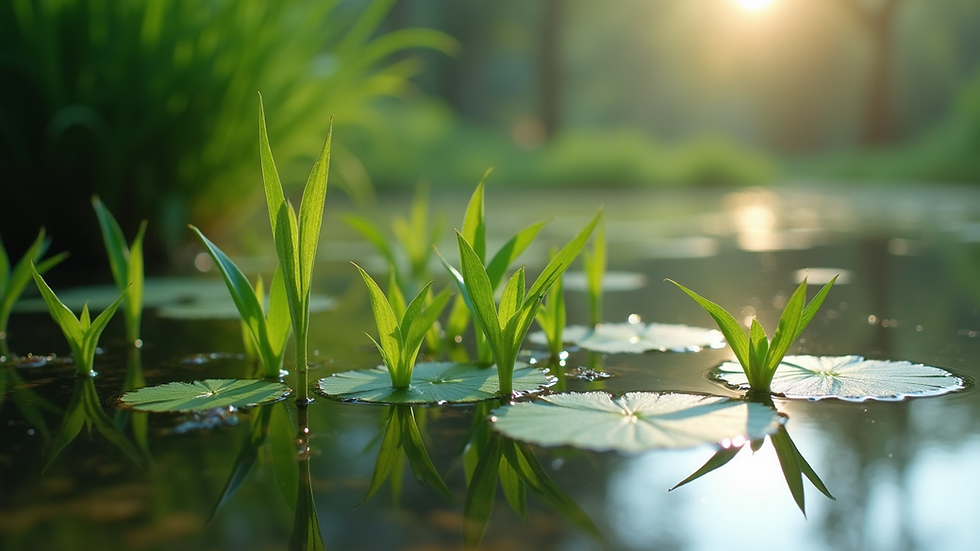Effective Tips for Swimming Pond Maintenance
- Jack Wooller
- Sep 15
- 4 min read
Creating a beautiful water feature in your garden is a wonderful way to enhance your outdoor space. If you have a swimming pond, you know how rewarding it is to enjoy clean, clear water surrounded by nature. However, maintaining this natural oasis requires some care and attention. The good news is that with the right approach, you can keep your pond healthy and eco-friendly without much hassle. I’m here to share practical tips that will help you maintain your pond effectively while respecting the environment.
Understanding the Basics of Eco-Friendly Swim Pond Care
Before diving into maintenance tasks, it’s important to understand what makes a swim pond eco-friendly. Unlike traditional pools, these ponds rely on natural filtration systems, plants, and beneficial bacteria to keep the water clean. This means fewer chemicals and less energy use, which is better for the environment and your health.
To start, focus on balancing the ecosystem within your pond. This involves:
Encouraging the growth of aquatic plants that absorb nutrients and provide oxygen.
Introducing beneficial bacteria that break down organic matter.
Avoiding harsh chemicals that can harm wildlife and plants.
By maintaining this balance, you reduce algae growth and keep the water clear naturally.

Practical Steps for Eco-Friendly Swim Pond Care
Maintaining your pond doesn’t have to be complicated. Here are some straightforward steps you can take regularly:
Skim Debris Daily
Leaves, twigs, and other debris can quickly accumulate on the surface. Use a net to remove them daily or every few days. This prevents organic matter from sinking and decomposing, which can cause water quality issues.
Check Water Levels
Evaporation can lower water levels, especially in summer. Keep an eye on this and top up with fresh water as needed. Use rainwater if possible to avoid adding chemicals from tap water.
Maintain Plant Health
Trim dead or dying leaves from aquatic plants. Healthy plants absorb nutrients that would otherwise feed algae. Consider adding native plants that thrive in your local climate.
Clean Filters and Pumps
If your pond has mechanical filters or pumps, clean them regularly to ensure they work efficiently. This helps maintain good water circulation and filtration.
Monitor Water Quality
Test the water for pH, ammonia, and nitrate levels every few weeks. Keeping these in balance supports a healthy pond environment.

Seasonal Maintenance Tips for Your Pond
Each season brings different challenges and opportunities for pond care. Here’s how to adapt your routine throughout the year:
Spring: This is the time to prepare your pond for the warmer months. Remove any debris that accumulated over winter. Divide and replant aquatic plants if needed. Check equipment and repair any damage.
Summer: Keep an eye on water temperature and evaporation. Shade parts of the pond with floating plants to prevent overheating. Regularly skim debris and clean filters.
Autumn: As leaves fall, increase skimming frequency to prevent buildup. Cut back dead plant material and remove it from the pond. Consider installing a net over the pond to catch falling leaves.
Winter: If your pond freezes, avoid breaking the ice as this can harm aquatic life. Use a pond heater or aerator to keep a small area ice-free for gas exchange.

Encouraging Wildlife and Biodiversity
A well-maintained pond attracts a variety of wildlife, which helps keep the ecosystem balanced. Frogs, dragonflies, and beneficial insects all play a role in controlling pests and maintaining water quality.
To encourage wildlife:
Provide shallow areas for amphibians to breed.
Plant native wildflowers around the pond to attract pollinators.
Avoid using pesticides or herbicides near the pond.
By supporting biodiversity, you create a thriving, natural environment that benefits both your pond and the surrounding garden.
Tools and Products That Support Eco-Friendly Pond Care
Choosing the right tools and products can make maintenance easier and more sustainable. Here are some recommendations:
Manual Skimmers and Nets: Simple tools that help remove debris without disturbing the pond.
Solar-Powered Pumps: These reduce energy consumption and keep water moving naturally.
Natural Pond Treatments: Use products based on beneficial bacteria or enzymes to improve water quality without chemicals.
Compostable Plant Pots: When adding new plants, choose eco-friendly pots to reduce plastic waste.
Using these tools supports your goal of maintaining a beautiful pond with minimal environmental impact.
Keeping Your Pond Beautiful Year-Round
Maintaining a swimming pond is a rewarding experience that connects you with nature. With regular care and attention, your pond will remain a stunning feature in your garden. Remember to be patient - natural systems take time to balance, but the results are worth it.
If you ever feel unsure about your pond’s health or need expert advice, don’t hesitate to reach out to professionals who specialise in eco-friendly aquatic environments. They can help you design, build, and maintain a pond that fits your lifestyle and respects the local ecosystem.
By following these tips, you’ll enjoy a clean, clear, and vibrant pond that enhances your outdoor space and supports local wildlife. Happy pond keeping!




Comments